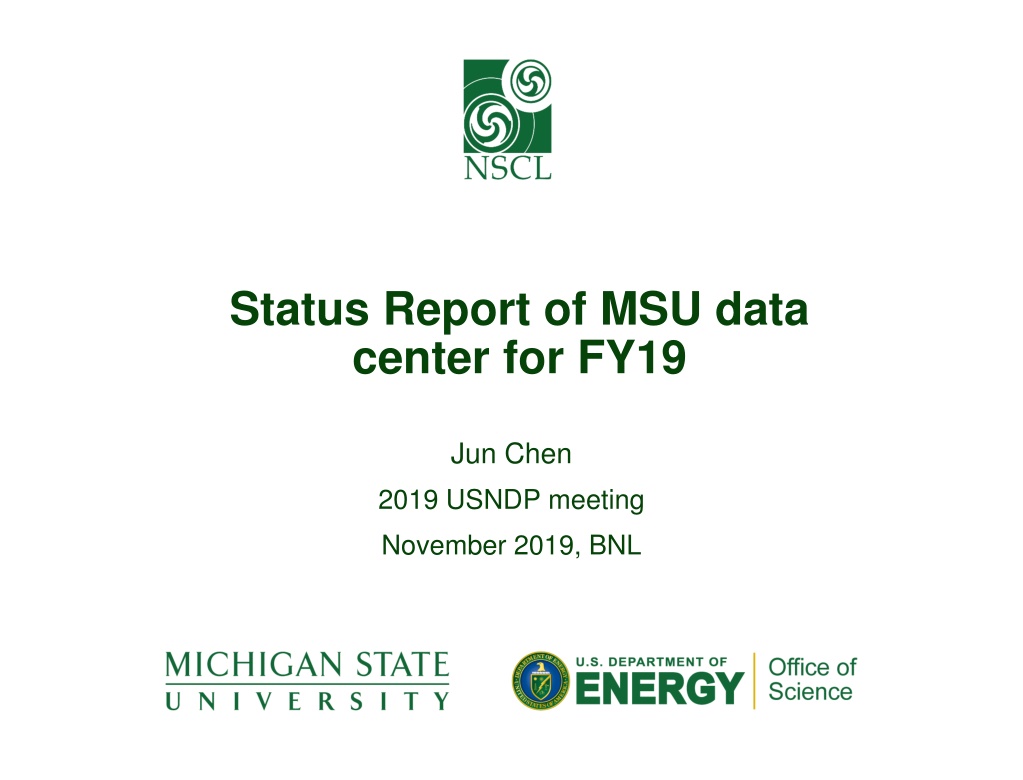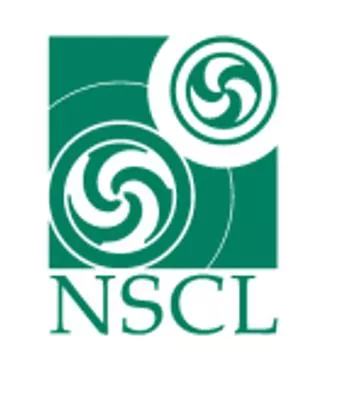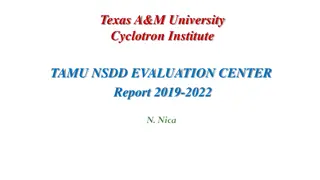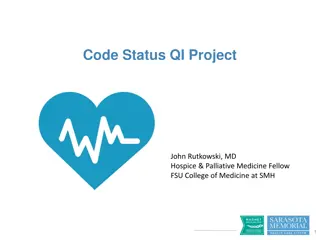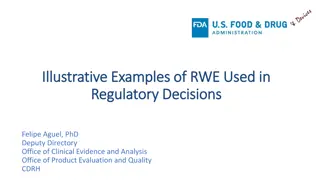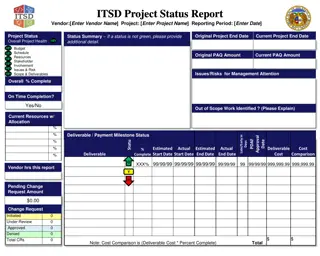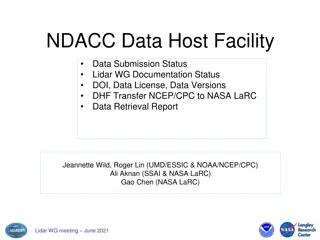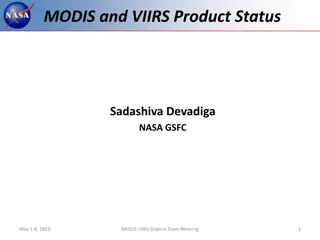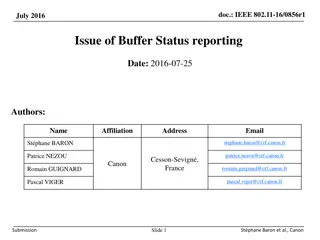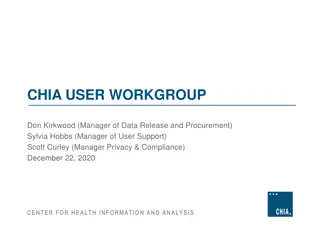MSU Data Center Status Report FY19
MSU Data Center provides updates on ENSDF evaluation, XUNDL compilation, and code developments for nuclear data in FY19. The report includes funding details, personnel information, completed tasks, and upcoming goals for FY20.
Download Presentation

Please find below an Image/Link to download the presentation.
The content on the website is provided AS IS for your information and personal use only. It may not be sold, licensed, or shared on other websites without obtaining consent from the author. Download presentation by click this link. If you encounter any issues during the download, it is possible that the publisher has removed the file from their server.
E N D
Presentation Transcript
Status Report of MSU data center for FY19 Jun Chen 2019 USNDP meeting November 2019, BNL This material is based upon work supported by the U.S. Department of Energy Office of Science under Cooperative Agreement DE-SC0000661, the State of Michigan and Michigan State University. Michigan State University designs and establishes FRIB as a DOE Office of Science National User Facility in support of the mission of the Office of Nuclear Physics.
MSU nuclear data center Independently funded by DOE in FY19 budget cycle (1 year): 12/15/2018 to 12/14/2019 awarded in 01/2019 FY20 renewal underway recommendation received from DOE on 10/25/2019 expected to be awarded in 12/2019 Data personnel: 1.0 FTE (since 12/2014) Primary responsibilities: ENSDF evaluation (A=31-44) XUNDL compilation Code development 2019 USNDP meeting Jun Chen
ENSDF evaluation at MSU Current Responsibility: A=31-44 currently all are up-to-date (10-year update cycle) the oldest one was updated in 2011 Completed in FY19: #of #of #of Adopted Levels 1255 829 1462 #of Adopted Gammas 1762 1332 2393 A #of lines nuclides 15 13 17 datasets 85 71 101 A=123 A=190* A=149* 20,599 16,918 26,175 * in collaboration with Balraj Plan for FY20 A=194 (14 nuclides) and A=64 (13 nuclides), in collaboration with Balraj A=xxx (to be determined) 2019 USNDP meeting Jun Chen
XUNDL compilation at MSU Commitment: one paper/week Completed in FY19: o 152 data sets from 54 papers including 7 PRC-XUNDL data review Goal for FY20: o ~80 data sets from ~50 papers Student involvements o trained top MSU undergraduates (recruited by Prof. H. Iwasaki) for XUNDL compilation: 2018: Amani Ahnuar current: Pranjal Dangwal, Dave Lempke (both from Honors College in MSU) 2019 USNDP meeting Jun Chen
XUNDL compilation at MSU Commitment: one paper/week Amani Completed in FY19: o 152 data sets from 54 papers including 7 PRC-XUNDL data review Goal for FY20: o ~80 data sets from ~50 papers Student involvements o trained top MSU undergraduates (recruited by Prof. H. Iwasaki) for XUNDL compilation: 2018: Amani Ahnuar current: Pranjal Dangwal, Dave Lempke (both from Honors College in MSU) Dave Pranjal 2019 USNDP meeting Jun Chen
Code developments at MSU ConsistencyCheck o Check data consistency among datasets, e.g., JPI, MULT, XREF, T1/2, etc. o Group levels and gammas to assist in preparing Adopted dataset o Average EG, RI, T1/2 and generate averaging comments in ENSDF o Other functions: setting up evaluation folders, sorting, merging/splitting datasets, etc. Java-RULER o written in Java with all functions as in the old Fortran version o Solve issues with error propagations of large and asymmetric uncertainties KeynumberCheck o Check all NSR keynumbers in datasets for format errors, irrelevant or nonexistent keynumbers (mostly due to mistyping) Excel2ENSDF o A Java version of the Python codes xls2ens and ens2xls combined, with easier usage o Convert a tabulated Excel table to an ENSDF file, and vice versa o Also useful for multiplying a factor or adding a constant (or both) to all values of a record in an ENSDF file, e.g., adding S(n) to E(n) 2019 USNDP meeting Jun Chen
List of Java codes developed/maintained at MSU Name Functions Note Last Update October 22, 2019 ConsistencyCheck check data consistency among ENSDF datasets, group levels and gammas, and average values from different datasets (with user selections), and more considered as replacement of PANDORA with more functions; useful for preparing Adopted dataset extensively used in XUNDL compilation and useful for extracting tabulated data from ENSDF October 11, 2019 convert BETWEEN an Excel file (formatted data) and an ENSDF file; perform simple operations on column data in Excel, such as multiplying a factor or adding a constant (or both) to all values of a record, e.g., adding S(n) to E(n) Excel2ENSDF June 6, 2019 calculate gamma-ray transition strengths in ENSDF file with proper error propagations of large/asymmetric uncertainties solved a long-standing uncertainty calculating issue in the old FORTRAN code Java-RULER September 13, 2019 check all NSR key-numbers in ENSDF datasets for format errors, irrelevant or nonexistent key-numbers (mostly due to mistyping) by searching in an input list of key-numbers or in the NSR database directly. useful to catch incorrect, irrelevant or non-existent key- numbers for the final check of an ENSDF evaluation KeynumberCheck November 7, 2019 generate LaTeX and PDF outputs from ENSDF file(s) for Nuclear Data Sheets and web-display of ENSDF and XUNDL databases on NNDC retrieval webpages started at McMaster by Balraj and his students Java-NDS 2019 USNDP meeting Jun Chen
Proposed Expanded FRIB Nuclear Data Effort Addresses Data Needs in the FRIB Era Addresses the diverse nuclear data needs in the FRIB area Takes full advantage of synergies between data efforts in nuclear structure, reactions, astrophysics, and theory Maximizes scientific impact and enables discoveries Aligned with conclusions from 2016 Data Workshop at Low Energy Community Meeting Complements existing efforts, integrated with NNDC Takes advantage of leverage opportunities at MSU 0.5 FTE Nuclear Structure Evaluation Another nuclear structure data evaluator at MSU to ensure the proper and timely compilation (XUNDL) and subsequent evaluation (ENSDF) of FRIB data 0.5 FTE Nuclear Astrophysics Evaluation Makes nuclear data usable in astrophysics Focus on reaction rate data evaluation Connects structure data, reaction data, theory data and theory tools Leverage opportunity with NSF Networks JINA-CEE and IReNA (community connection, field wide standards, ensure impact) 0.5 FTE Nuclear Theory Provide a theoretical counterpart to ENDSF, fully integrated with NNDC Theory data evaluation, curation, and dissemination Structure Astrophysics Theory
ENSDF ConsistencyCheck code Jun Chen 2019 USNDP meeting November 2019, BNL This material is based upon work supported by the U.S. Department of Energy Office of Science under Cooperative Agreement DE-SC0000661, the State of Michigan and Michigan State University. Michigan State University designs and establishes FRIB as a DOE Office of Science National User Facility in support of the mission of the Office of Nuclear Physics.
ConsistencyCheck: user interface check data consistency among ENSDF datasets, group levels and gammas, and average values from different datasets (& additional functions)
ConsistencyCheck: usage and outputs The usage is simple: load an ENSDF file containing all datasets to be checked or load multiple single-dataset files at one time (drag and release files into the message window to load files) select files, drag & drop (no changes made to input files) Output files: (e.g., for A=73) 73.err: error reports 73.mrg: grouped lines of all datasets 73.avg: average results of records(T1/2,E ,I ) 73.adp: adopted dataset based on auto-grouping 73.fed: list of feeding gammas to each level 73.wrn: warning reports 73.lev: tabulated level information 73.gam: gammas grouped by gamma energy 73.gle: gammas grouped by level energy
ConsistencyCheck: customized averaging select datasets for averaging select gamma results automatically generated averaging comment for copy and paste into dataset
ConsistencyCheck output: averaging report (.avg) can select entries to average in GUI .avg output file averaging results weighted comments (for selected entries) weighted comments (for all entries) for copy and paste unweighted comments
ConsistenchCheck: list of feeding Gammas Dataset DSID Initial level Feeding Gammas select level also in .fed output file
ConsistencyCheck output: grouped entries (.mrg) all records and comments of the same property from different datasets at a glance New XREF after dataset sorting & Original XREF .mrg output file ENSDF record and comment lines of a same gamma from different datasets final levels DSID & XREF tag
ConsistencyCheck output: grouped entries (.mrg) summary table for statistics of levels and gammas from all datasets .mrg output file
ConsistencyCheck output: error report (.err) .err output file error and warning messages
ConsistencyCheck: checklist This program performs the following checks: (1-7 from suggestions at Duke workshop in August 2019) 1. check consistency for adopted values in comments, as quoted from Adopted dataset 2. check consistency between uncertainties in alpha-decay HF and IA records of g.s. 3. check if flag=1U is missing for log ft~8.5, J=2, =yes 4. check if records of mass and moment in Adopted datasets are updated 5. check if L-transfers in transfer reactions (when target JPI is given for non even-even) is consistent with Adopted JPIs 6. check consistency for JPI of band-head quoted in band title 7. check consistency for J of in-band transitions: must be same for BAND otherwise SEQ
ConsistencyCheck: checklist (cont.) 8. check consistency of gamma-ray multipolarity with change of spin and paritybetween parent and daughter levels 9. check consistency of log ft value with change of spin and parity between parent and daughter levels for beta/EC decay dataset If 3.6<log ft<5.9, then, Ji-1<=Jf<=Ji+1, no parity change If 3.6<log ft<6.4, then, transition can t be 0+ ---> 0+ If log ft>=8.5 and 1U, then, Jf=Ji+/-2, with parity change 10. check consistency of HF value with change of spin and parity between parent and daughter levels for alpha decay dataset: If mass=odd and HF<4, then, Jf=Ji, no parity change If Jf=0 or Ji=0, then, parity change=(-1)^(Jf-Ji), with +1 for no change and -1 for change 11. check consistency of spin-parity values in Adopted Levels with those in individual datasets if there is any comment stating that they are from Adopted Levels 12. check consistency of information in parent record in decay dataset with the Adopted data for the parent nuclide, like, JPI, T1/2, Q-value
ConsistencyCheck: checklist (cont.) 13. check BXLW values in continuation records with RUL values for Adopted Level, Gammas dataset 14. check if any level from individual datasets is missing in Adopted Levels dataset or if its XREF tag is missing in the XREF= field of the corresponding Adopted Level 15. check if the XREF= field of an Adopted level has any wrong XREF tag. 16. check 0 to 0 transition, parity-change=yes should not happen 17. check if Ig is normalized to strongest=100 (PN=6) in Adopted Gammas, and that should not normalized to gamma flagged by ?, *, & 18. check decay branch with DJ>2 or (DJ==2 and parity change=no), less likely 19. check if any gamma is missing in Adopted Gammas 20. check if T1/2 as quoted from Adopted is consistent 21. check if MULT and MR as quoted from Adopted is consistent 22. check if BXLW is missing in Adopted Gammas when T1/2, Ig, MUL are available 23. check MULT=E0, flagging that CC should be from experimental data 24. check MS flag in column 78-79 for level record with T1/2>=100 ns
ConsistencyCheck: dataset viewer quick switch among datasets line number for quick locating different color for L and G lines for easy reading and quick finding more features to be implemented (text not editable)
ConsistencyCheck: other functions Right-click on blank area above for this pop-up menu
ConsistencyCheck: other functions (cont.) create a default evaluation folders automatically sort and merge all files in all new folders into a single file An example structure of evaluation folders created from an input mass-chain file, with each dataset saved to an individual ENSDF file named by DSID
ConsistencyCheck: other functions (cont.) Sort and Merge all input ENSDF files into a single file
ConsistencyCheck: other functions (cont.) Save each dataset in input ENSDF files to an individual file by the name of its DSID
ConsistencyCheck: other functions (cont.) Create a simple Adopted dataset based on automatic grouping of all available datasets, with a new XREF summary table average values for E(level), T1/2, E(gamma), I(gamma) fields, where available automatically generated averaging comments automatically selected best value for other fields
ConsistencyCheck: other functions (cont.) Clean up input ENSDF files: o fixing line-length=80 o converting upper-case "C" comments to lower-case "c" comments. o outputs are written into new files labelled by "CLEANED" in file names
ConsistencyCheck: other functions (cont.) checked by default to convert relative RI in all datasets to PN=6 intensities for Adopted dataset. uncheck it for averaging original RI values
